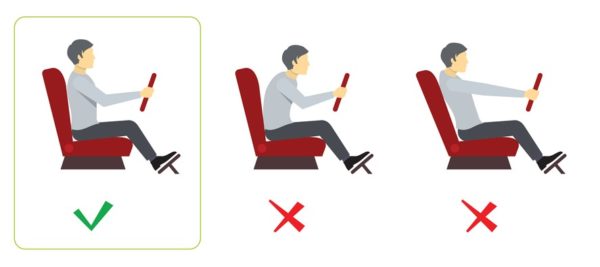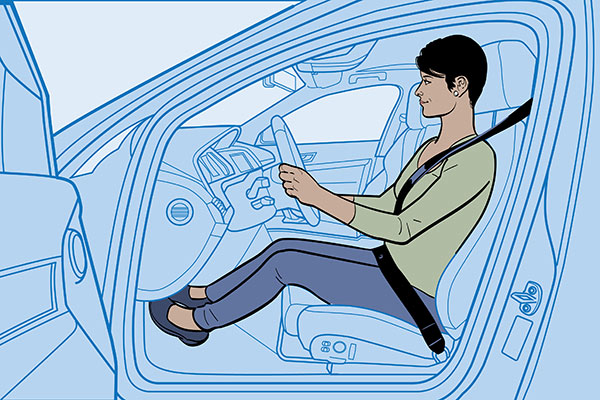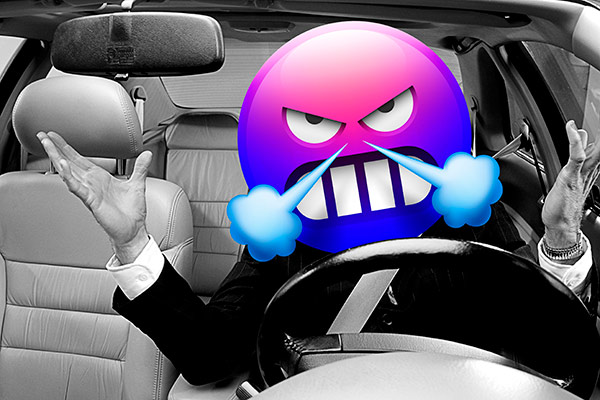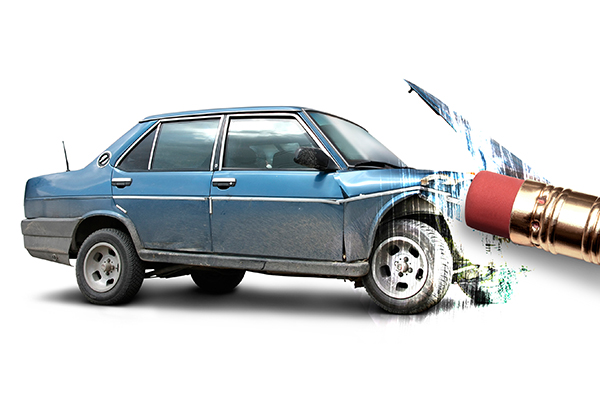An achy back, stiff neck, sore shoulders: The everyday shakes, rattles and rolls of daily commuting can take a toll on your body.
The vehicles we drive are part of the problem. Some car seats don’t adequately accommodate the curve of the lower back, putting additional strain on the spine. And compact cars may lack legroom and head space, forcing some drivers to contort their bodies into unhealthy positions just to operate the vehicle.
But it’s not always the car’s fault, says Dr. Ginger Edgecombe Dorsey, Ph.D., Ergonomics Program Manager for the USDA Animal and Plant Health Inspection Service (APHIS). Sometimes the problem is simply how we sit. In her ongoing poll of USDA employees, she finds that poor driving posture can lead to an increased risk of discomfort in the neck, back, shoulders, arms, wrists, fingers, legs and feet. Over time, she says, bad posture could result in chronic pain, making you vulnerable to more injuries.
And sore limbs may be the least of it: One study found that poorly positioned drivers also have an increased risk of serious injury if they get into an accident.
Fortunately, you can alleviate many posture-related discomforts with proper adjustment of the driver’s seat and mirrors. Here’s what Dorsey recommends.
 1. Support Your Back
1. Support Your Back
Slide your tailbone as close to the seat back as possible. Aim for a two- to three-finger gap between the back of your knees and the front of your seat. If your vehicle doesn’t allow for the proper position, a lumbar or back cushion may help.
2. Lift Your Hips
If you can, adjust your “seat pan” (the part you sit on) so that your thighs are supported along their entire length and your knees are slightly lower than your hips. This will increase circulation to your back while opening up your hips.
3. Don’t Sit Too Close
You should be able to comfortably reach the pedals and press them through their full range with your entire foot. Safety is also a consideration here; this study suggested that drivers whose chests were closer to the wheel were significantly more likely to suffer severe injuries to the head, neck and chest in front- and rear-end collisions.
4. Get The Right Height
Make sure your seat raises your eye level at least three inches above the steering wheel while allowing sufficient clearance between your head and the roof.
5. Lean Back (A Little)
The angle of your seat back should be a little greater than a perpendicular 90 degrees. At 100 to 110 degrees, the seat will put the least pressure on your back. Leaning too far back forces you to push your head and neck forward, which can cause neck and shoulder pain and tingling in the fingers.
6. Set Your Headrest
Set the top of the headrest between the top of your ears and the top of your head; it should just touch the back of your head when you’re sitting comfortably. The headrest is also important in reducing whiplash injuries in the event of a rear-end collision, says NHTSA—so important, in fact, that standards were developed for it.
7. Use Lumbar Support
If your car has adjustable lumbar support, set it (using both the front-back and up-down controls) so you feel an even pressure from your hips to your shoulders. If your car doesn’t have automatic support, a lumbar pillow or even a rolled-up towel can help.
8. Adjust Your Mirrors
Prevent neck strain by making sure your rear-view and side mirrors are properly adjusted; you should be able to see the traffic behind you without having to crane your neck.
9. Take Breaks
Even when you’re perfectly situated in the driver’s seat, fatigue will inevitably set in, especially when you’re driving for long periods. Listen to your body. And take periodic breaks: Park safely at a rest stop or other designated stopping area to get out of the car and stretch.
Managing your auto insurance policy shouldn’t be a pain in the neck. See why GEICO Mobile was ranked #1 by the Keynova Group’s Mobile Insurance Scorecard for 5 years running and download the app today.
Read more: Everything you need to know about distracted driving.
By Robert Edbrooke









Annie T. DRUMMOND says,
great test, good to no that drive right.
Kathu says,
What I am talking about is the front seats slant to the back. Which causes you back and butt to hurt. Because you are not seating properly. Your spine is not in line. Seat needs to be level
LEROY PRESC0D says,
I LOVE THE FACT YOU SAID LISTEN TO YOUR BODY TO OFTEN WE DONT LISTEN TO OUR BODY AND END UP WITH SEVERE PAIN IN OUR BODY
Harold ARANDA says,
This is a very good and informative article. I immediately checked my posture corrected. More articles wil be appreciated, thank you
BLUF says,
Vehicles are not designed for people like me. The head restraints push the head forelward–promoting bad posture.
If I use the full range of my feet, I have to push my torso forward.
s says,
Agreed! I actually have to remove the headrest or turn them around. Some are worse than others but ALL push my head forward in an uncomfortable angle giving me poor posture, which leads to pain. Also, if not driving the curled forward sides of seats (torso area) negatively affect my posture by preventing my arms from hanging/resting naturally at my side.
Dorothy A. Debase says,
Thank you for the safety tips to apply to daily driving.